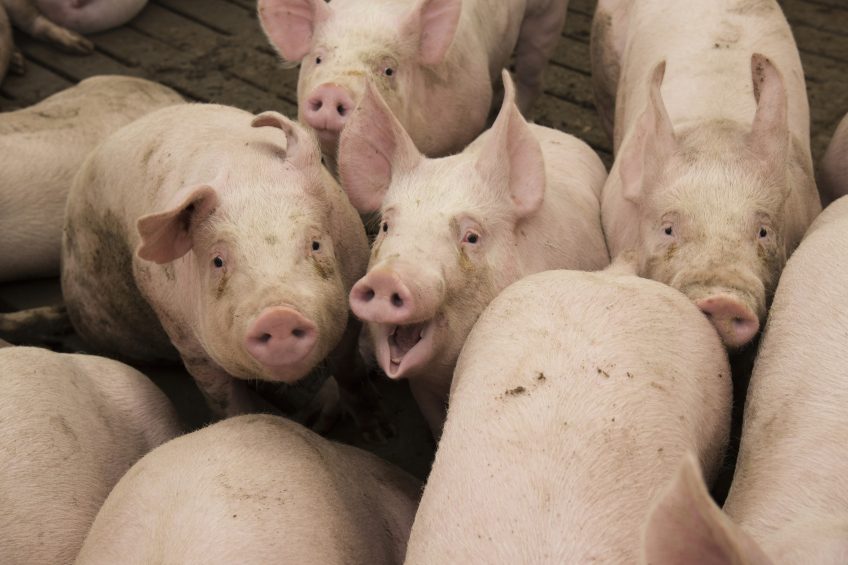Optimising amino acids in swine diets

For pig producers, failing to optimise dietary protein utilisation can result in significant negative impacts on animal health and performance, as well as increased production costs. Research demonstrates that it is possible to unlock the full nutritive potential in feed, resulting in sustainable profitability with reduced feed costs.
Feed is the single largest cost in pig production; the use of low-cost ingredients is, unsurprisingly, a common cost-cutting approach. This strategy typically involves the addition of ingredients with low energy density and high fibre – substitutes that make nutrients less accessible and negatively impact the hindgut.
The challenge of balancing feed quality with affordability has been compounded by the removal of antibiotics. Historically, antibiotics were used to reduce disease and environmental pathogens – both of which negatively impact feed efficiency and growth rate. Without antibiotics, the animal’s health and ability to utilise dietary protein is further impacted.
The pressure to reduce costs, combined with the elimination of antibiotics, has created the need for strategies to support pigs’ limited ability to digest fibre, while reinforcing their intestinal health and function. Many pig producers have become sceptical of feed additives, beyond phytase, due to disappointing results from past trials. However, emerging research has identified an enzyme/probiotic combination that consistently improves amino acid digestibility, reducing feed costs while enhancing growth and performance.
Inherent challenges in low-cost feed
While corn and soybean meal (commonly found in pig diets) have relatively high amino acid digestibility, they still contain considerable amounts of protein bound to fibre (about 1%). As feed cost decreases the fibre content increases, and with it the amount of fibre-bound protein. Corn distillers dried grains and solubles (DDGS) has 13.6% of its protein bound to fibre, for example.
Figure 1 – Microscopy visualisation of the microstructure of ileal digesta from pigs fed corn and wheat based diets demonstrated the presence of intact cell wall structures containing starch granules, protein and fat which had evaded digestion by the pigs’ own digestive enzymes.

Fibre-bound protein poses nutritional and health challenges. Numerous studies suggest that armed only with an endogenous digestive capacity of the small intestine, pigs lack the ability to break down and liberate nutrients from the fibre-protein complex. In fact, recent research revealed feed to have intact cell walls containing starch, protein and fat that completely evaded digestion in the small intestine (see Figure 1).
When this happens, these fibre-bound nutrients enter the hindgut where microbial fermentation occurs, resulting in higher concentrations of ammonia and amines. Higher ammonia levels not only negatively impact the development of the gut structure, decreasing the digestive and absorptive function of the gut, they also increase the amount of ammonia excreted in the manure. Exposure to ammonia levels as low as 10 ppm have been shown to increase the incidence of bacterial growth and respiratory infection, a result which decreases efficiency and profitability.
Importance of amino acids
As the building blocks of protein, amino acids play multiple roles in pig health and performance. The amino acids needed to support an immune response are similar to those necessary for growth. This means amino acids are diverted away from growth when a pig’s immune system is challenged. Compounding research suggests that a key limiting factor to pigs’ growth and feed efficiency is an adequate supply of digestible amino acids, and that this may also be responsible for some animal welfare issues.
It has been suggested that supplementing essential amino acids in diets with reduced dietary protein, creates the potential to improve nutrient efficiency without compromising performance. Other research, however, submits that reducing protein can increase the incidence of damaging behaviour in swine, such as tail and ear biting. While the relationship between health status and behaviour is not wholly understood, a shortage of specific essential amino acids often leads to increased foraging behaviour, which translates to biting and other stereotypic behaviours for pigs in confinement.
The increasing evidence that links amino acid availability to growth limitations and animal welfare issues is magnified in pigs with low health status, those living in suboptimal housing conditions, or when fed high-fibre, heat-treated, or processed ingredients.
Optimising amino acid availability
Liberating the undigested protein fraction in pig feed requires complex biochemical activities that depend largely on the diet composition – a fact that may explain the inconsistent performance of feed additives in the past. Recent advances show promise for better understanding diet composition. Screening studies aimed at finding a way to improve solubility of the fibre-protein complex in the small intestine of grower pigs showed the greatest results, using a combination of a protease/multi-strain probiotic.
Syncra SWI combines an exogenous protease, known for its ability to break down protein, with a multi-strain Bacillus probiotic (direct-fed microbial or DFM) capable of adjusting the type and quantity of enzymes it produces. The adaptiveness of the probiotic allows it to support protease activity with complementary enzyme activities specific to the type of substrate present in the small intestine. In other words, the same additive consistently degrades substrate in many different feed ingredients.
Figure 2 – Results of a combined analysis of six individual grower-finisher pig trials. Effects of the addition of a three-strain Bacillus probiotic and a protease* to the control diet.

In addition, the exogenous protease enzyme targets a wide range of amino acid sequences complementary to a pig’s specific endogenous protease activity. The protease and fibre-degrading enzymes from the multi-strain probiotic work synergistically to provide exceptional protein breakdown, targeting fibre-bound protein and liberating amino acids and other nutrients.
Results of an adaptive solution
In a combined analysis of six individual grower-finisher pig trials, addition of a three-strain Bacillus probiotic and a protease to the control diet led to significant increases in average daily gain (ADG) and feed conversion ratio (FCR) of 3 and 4% respectively (Figure 2). Improvements in liveability (1-2%) were also seen across 5 individual trials where over 5,000 pigs were reared under commercial conditions (see Figure 3).
Affordable solutions
The use of adaptive feed additives can optimise amino acid utilisation and boost performance economically. One study, which explored the potential of this strategy to increase the digestibility of amino acids in pigs already fed a corn/soybean meal-based diet, showed an overall average improvement of 33% in the apparent digestibility of amino acids when expressed as a function of the undigested fraction. Furthermore, feed conversion ratio (FCR) improvements of more than 3% were seen over the control, demonstrating a level of consistency that has allowed researchers to generate a robust amino acid and energy matrix. When applied to a corn/soybean meal/corn DDGS-based diet, the matrix shows a cost savings of $ 4.00 to $ 11.00 per short ton (907 kg).
Figure 3 – Results of five individual trials including 5,000 pigs, using a three-strain Bacillus probiotic and a protease* to diets.

Optimising dietary protein utilisation
Research demonstrates how an adaptive combination of a protease and multi-strain Bacillus can breakdown otherwise indigestible substrates and lead to improved growth performance for sustainable profitability. It maximises energy and amino acid digestibility for consistent performance across multiple substrates, strengthening the gut-health barrier and facilitating the production of short chain fatty acids.
With its proven energy and amino acid matrix values, Syncra SWI offers a novel solution aimed at unlocking the full nutritive potential in feed, for sustainable profitability with reduced feed cost.











